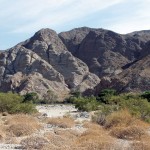Coachella Valley Mountains Conservancy Acquisition Priorities – 2013

The Conservancy’s mission under state law is to protect lands with “open-space, wildlife, scenic, environmental, anthropological, cultural, scientific, educational and recreational resources”, including both mountainous lands surrounding the Coachella Valley and natural community conservation lands as identified in the Coachella Valley Multiple Species Habitat Conservation Plan (“CVMSHCP”). The priorities set forth here update and revise the Acquisition Priorities set by the Conservancy Board in March, 2007. The priorities also seek to establish initial criteria for evaluating potential acquisitions, with the understanding that ranking particular properties can be a subjective exercise and that the circumstances surrounding the availability of willing sellers or funds to support purchases will necessitate careful analysis of each site.
All acquisitions properties must be within a CVMSHCP Conservation Area and preserve or promote one or more of the following conservation objectives:
- Biological resources, such as important plant or wildlife habitat or hydrologic features
- Cultural resources
- Recreational options consistent with habitat values
- Significant scenic attributes.
In general, properties that fulfill more than one of the conservation objectives will be preferred for acquisition to those that meet only one objective. However, each potential acquisition site is unique and the ultimate decisions on acquisition will rest with the Conservancy’s board.
Other attributes or factors in establishing priority:
- Likelihood of imminent or future development
- Partnership or fund leveraging opportunities
- Potential for future transfer to federal or local agency or non-profit organization
- Complements adjacent or nearby public or nonprofit holdings
- Availability of public agency or nonprofit entity to take and hold title
- Funding options for future management and monitoring
- Ease of monitoring and low risk of interference from adjacent or nearby uses
- Rising land values in area
- Other special circumstances, e.g., seller motivation, foreclosure or tax sale offering, property condition, presence of improvements or hazardous materials.
Applying the conservation priorities above in light of the progress the Conservancy and its partners have made since 2007 in acquiring conservation lands yields the following updated list of project areas in which will be the focus of most acquisition work in the coming years:
- San Jacinto Mountains (including the Chino Cone area) and Santa Rosa Mountains alluvial fans (in La Quinta, Oasis, Thermal and Vista Santa Rosa, as well as Palm Hills) – contain cultural resources, scenic resources within and adjacent to the National Monument and significant habitat values for Peninsular bighorn sheep, along with future recreational options.
- Stubbe Canyon corridor – includes significant wildlife corridor between the San Jacinto and San Bernardino Mountains, sand transport essential areas and high quality riparian habitat, as well as trail alignment opportunities. (Approximately 80% of the potential conservation acquisitions here have been completed.)
- Lake Cahuilla shoreline – protects this unique historical shoreline and important cultural resource area from potential development and connects it to other conservation areas. (Approximately 90% complete.)
- Sand transport areas in Willow Hole, Thousand Palms and Edom Hill areas – where many parcels are in the CVFTL Preserve/Area of Critical Environmental Concern (ACEC), providing excellent habitat for CVFTL, Coachella Valley milkvetch, Coachella valley round-tailed ground squirrel, and Palm Springs pocket mouse. Many sites contain cultural resources and could provide trail alignment opportunities; there is a significant threat of development for many properties. (Approximately 50 % complete.)
- Thermal Canyon/Mecca Hills/Orocopia Mountains Wilderness areas – in the Joshua Tree National Park Wildlife Movement Corridors, which include significant desert dry wash woodland and the I-10 scenic gateway area; and the Paradise Valley site should it become available. (Approximately 50% complete.)
- Joshua Hills inholding (Section 30) – contains habitat, public access to future State Park facilities and maintaining the “wilderness” quality of this area. (Approximately 90% complete – prior acquisitions were the former Cathton property and several earlier Joshua Hills projects.)
- Dos Palmas area – contains existing valuable habitat as well as future potential linkages for wildlife movement and connects to other publicly owned land in the Dos Palmas ACEC. Due to location near the Salton Sea, it also may facilitate future cooperative projects that allow funds to be leveraged.
- East Valley Canyon Protection Project (EVCPP) – portions of the Desert Tortoise/Linkage, Mecca Hills/Orocopia Mountains, West Deception Canyon and the Indio Hills/Joshua Tree National Park Linkage Conservation Areas, which contain significant habitat as well as potential linkages for wildlife corridors at the mouths of significant canyons. They also contain significant historical resources due to their proximity to the Colorado River Aqueduct and represent future trail opportunities.
- Any project area – transfers of previously acquired land to federal agencies to relieve management obligations and/or receive repayment of CVMC grants, which then can be used to purchase additional properties.
Approved by the Coachella Valley Mountains Conservancy Board on November 4, 2013.
